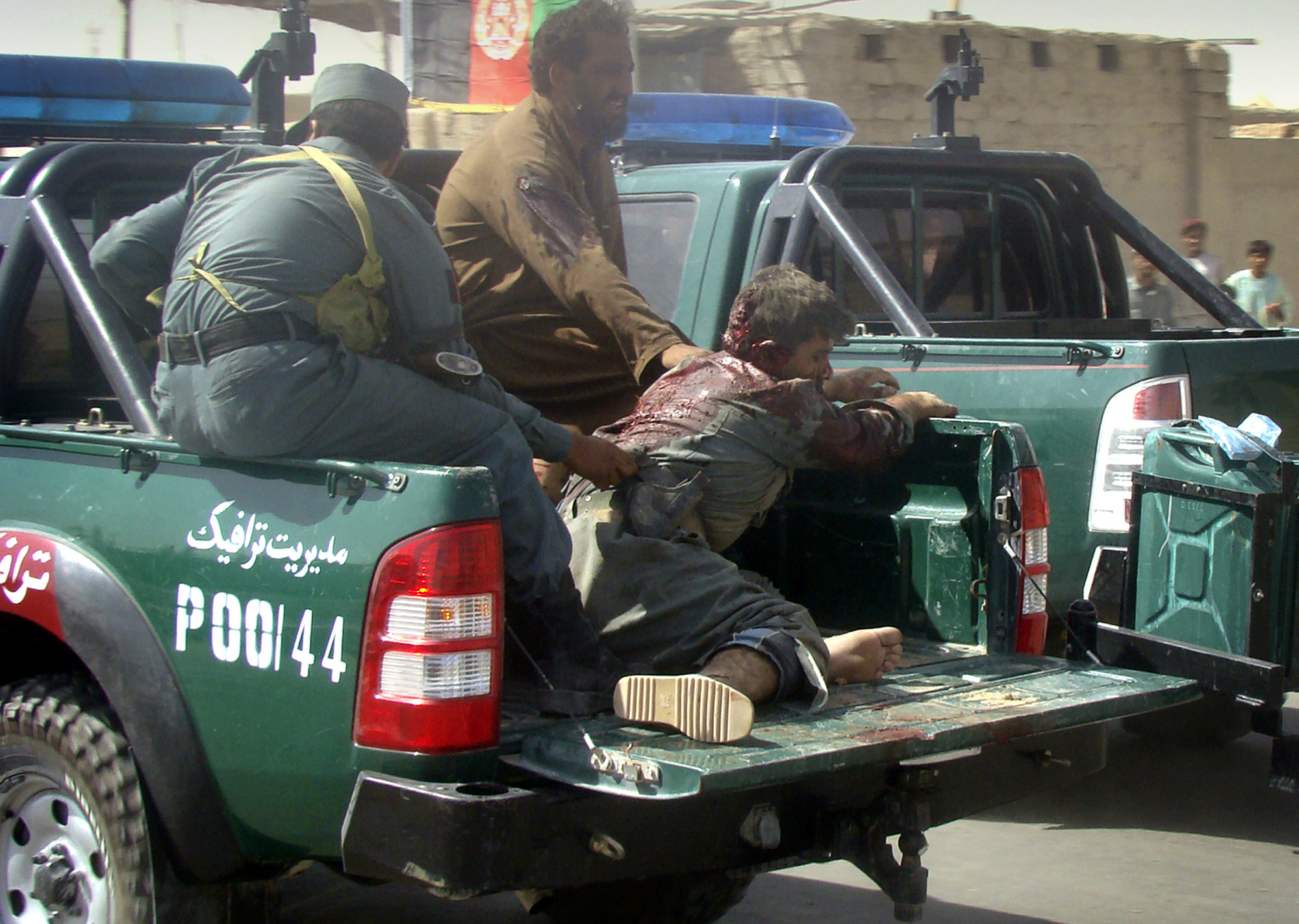Violent incidents up 39 percent in Afghanistan
Thursday, September 29, 2011
 An injured Afghan police officer is transported on the back of a vehicle after a suicide attack in Lashkar Gah, Helmand province, Afghanistan. A suicide bomber rammed a car packed with explosives into a police truck outside a bakery in southern Afghanistan on Tuesday, killing a number of civilians, officials said.
An injured Afghan police officer is transported on the back of a vehicle after a suicide attack in Lashkar Gah, Helmand province, Afghanistan. A suicide bomber rammed a car packed with explosives into a police truck outside a bakery in southern Afghanistan on Tuesday, killing a number of civilians, officials said.By DEB RIECHMANN, Associated Press
KABUL, Afghanistan - The monthly average of armed clashes, roadside bombings and other violence in Afghanistan is running 39 percent ahead of last year's figure, U.N. reported Wednesday, with more complex suicide operations involving multiple bombers and gunmen.
The statistics show that the intensity of the nearly decade-old war is growing, not abating, as the U.S. and other nations start to withdraw some forces with an eye toward pulling all combat troops out by the end of 2014. The Taliban's resilience raises questions about whether the Afghan government and its Western allies have a solid grip on security - and whether the Afghan forces can ever secure the nation by themselves.
NATO says it has made progress in taming the Taliban insurgency by routing its strongholds in the south. But the Taliban have hit back with several high-profile attacks in the capital and assassinations of government officials and senior Afghan leaders.
In its quarterly report on Afghanistan, the U.N. said that as of the end of August, the average monthly number of incidents stood at 2,108, up 39 percent over the same period a year earlier. It did not provide comparable data. The figures include insurgent attacks as well as assaults by NATO and Afghan forces on Taliban figures and positions.
"Armed clashes and improvised explosive devices continued to constitute the majority of incidents," U.N. Secretary-General Ban Ki-moon said in his report. "The south and southeast of the country, particularly around the city of Kandahar, continued to be the focus of military activity and accounted for approximately two-thirds of the total security incidents."
The U.S.-led coalition said it disputes the U.N. figures and planned to hold a news conference Thursday to release its own statistics related to overall violence trends in Afghanistan.
Kandahar, the birthplace of the Taliban insurgency, was where most of the 33,000 additional U.S. troops that President Barack Obama sent to Afghanistan were deployed. The extra U.S. and other NATO forces succeeded in routing insurgents from their stronghold and now are trying to hold those areas in the south.
The militants, however, have opened new fronts in the north and west and have stepped up attacks in the east, including ones inside the heavily secured capital, Kabul.
According to the U.N. report, while the number of suicide attacks remained steady, insurgents conducted more suicide operations involving multiple bombers and gunmen. It said that on average, three complex attacks have been carried out each month from January to August - a 50 percent increase compared with the same period last year.
"Complex suicide attacks made up a greater proportion of the total number of suicide attacks," the report said.
Many of these attacks have taken place in Kabul.
On Aug. 19, Taliban suicide bombers stormed the British Council, the U.K.'s international cultural relations body, killing eight people during an eight-hour firefight as two English language teachers and their bodyguard hid in a locked panic room on the anniversary of the country's independence from Britain.
In July, gunmen strapped with explosives killed a close adviser to President Hamid Karzai and a member of parliament. The adviser was Jan Mohammed Khan, a former governor of a province in the south who advised Karzai on tribal issues.
In June, nine insurgents armed with explosive vests, rifles and rocket launchers stormed the Intercontinental Hotel, killing at least 12 people and holding off NATO and Afghan forces for five hours. Also in June, insurgents wearing Afghan army uniforms stormed a police station near the presidential palace and opened fire on officers, killing nine.
On May 21, a suicide bomber dressed in an Afghan soldier's uniform slipped inside the main military hospital in Kabul and killed six Afghan medical students.
The report reflects violence ending at the end of August, and high-profile attacks have continued since then.
On Sept. 13, militants fired rocket-propelled grenades and assault rifles at the U.S. Embassy, NATO headquarters and other buildings in Kabul. The attack killed seven Afghans in a coordinated daylight assault that lasted about 20 hours. No embassy or NATO staff members were hurt.
On Sept. 20, a single suicide bomber assassinated former Afghan President Burhanuddin Rabbani, who was leading a government effort to broker peace with the Taliban. The attack also wounded a key presidential adviser working to lure Taliban fighters off the battlefield.
Three international service members were killed in a roadside bombing in eastern Afghanistan on Wednesday, the U.S.-led coalition said. So far this year, 124 international troops have been killed in Afghanistan.
Also Wednesday, gunmen killed eight Afghan policemen during an ambush at a checkpoint near Lashkar Gah, the capital of Helmand province in the south. The city is one of seven areas of Afghanistan where Afghan security forces have started taking over from U.S.-led coalition forces.
Gen. Nabi Jan Mullahkhail, deputy regional commander in the south, said three policemen also were wounded in the pre-dawn attack. Mullahkhail said a policeman who was manning the checkpoint was missing. Authorities were investigating whether he might have been involved in the attack.
